I came across the same problem and I thought of a solution. Asuming that referenceImageMask and templateMask have 1s in the good pixels and 0s in the bad ones. And that referenceImage and templateImage have already been masked and have 0s in the bad pixels as well.
Then, the first result of template matching will give the not normalized cross correlation between the images. However, a bunch of pixels were zero.
The second template matching will give for each possible offset the number of pixels that were at the same time different from zero (unmasked) in both images.
Then, normalizing the correlation by that number should give the value you (and I) wanted. The average product for the pixels that are not masked in both images.
Image<Gray, float> imCorr = referenceImage.MatchTemplate(templateImage, Emgu.CV.CvEnum.TM_TYPE.CV_TM_CCORR);
Image<Gray, float> imCorrMask = referenceImageMask.MatchTemplate(templateMask, Emgu.CV.CvEnum.TM_TYPE.CV_TM_CCORR);
_imCorr = _imCorr.Mul(_imCorrMask.Pow(-1));
UPDATE: actually, this solution does not work. Because the implementation of the cross correlation in opencv uses the DFT there will be numeric issues and you cannot use the second crosscorrelation to correct the first one.





